Policy Management Software
Use our policy management software to build a centralised policy library, facilitate policy development, review, and distribution, automate approval processes, and obtain policy attestations. Automating policy management through software reduces administrative tasks, enhances collaboration, and provides reporting & tracking capabilities – enhancing oversight and accountability.
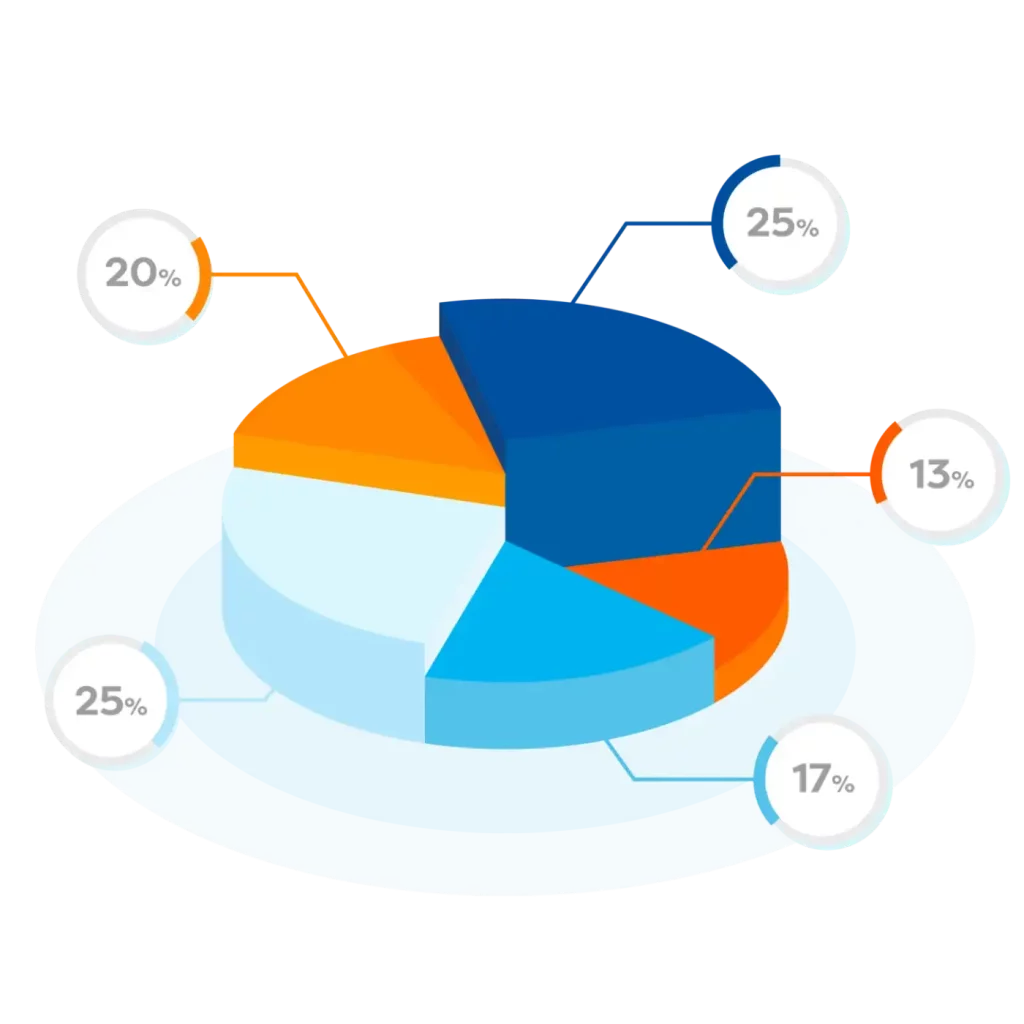
Maintain a Policy Library
Build a library of current policies and capture critical details around expiry date, owner, approver, version history, status, and review date. Link policies back to corresponding regulations and risks.
Automate Policy Workflows
Automate the creation, approval, signoff, distribution, and updating of policies using functionality like automated workflows, alerts, and email notifications.
Ensure Compliance
Track policy adherence through compliance monitoring, process workflows, regular compliance testing & checks, and online policy attestations.
Our policy management software solution can help in the following ways:
Policy Management Software Capabilities
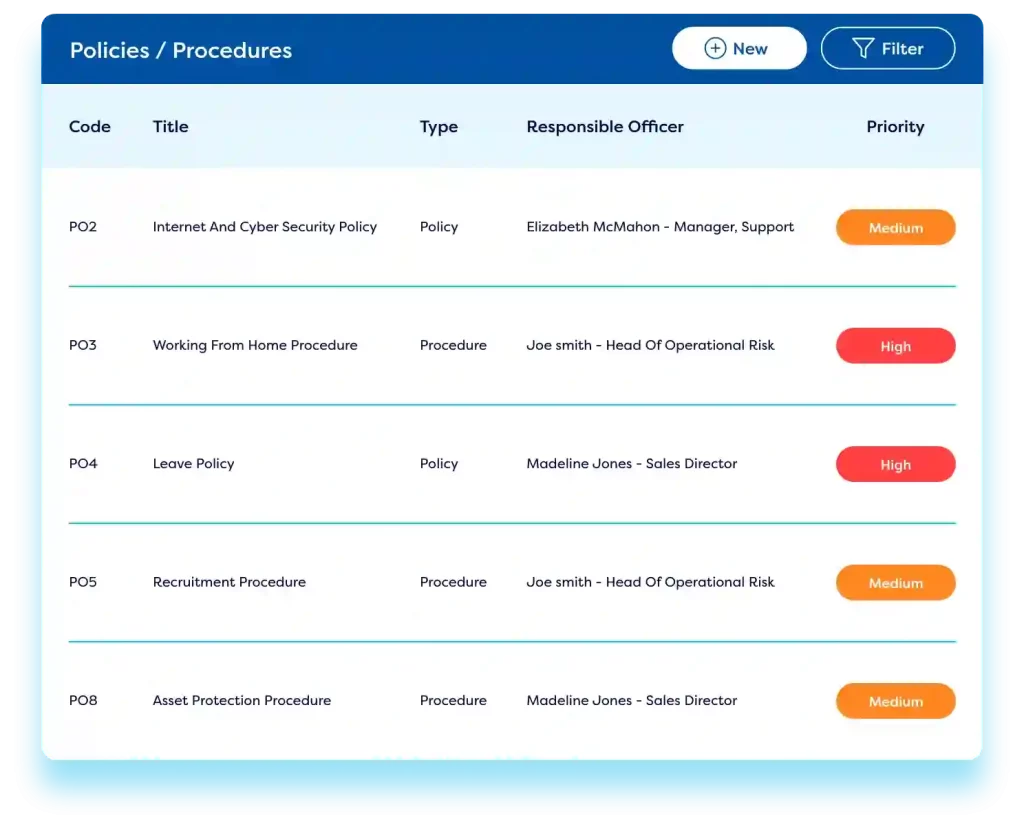
Build a Centralised Policy Library
Build a centralised online policy library and capture critical details around expiry date, owner, approver, version history, status, and review date. Policy document management software will create a single source of truth for important documents, eliminate paperwork, and consolidate all your policies in one secure accessible place. Easily upload new policies and sort and filter policies by their owner, status, expiry date or review date to keep track of policy deadlines.
Policy Templates & Workflows
Access best-practice templates and workflows to fully automate the entire policy lifecycle – from creation, approvals, and signoff to attestations and policy revisions. Once a policy is added to the system, teams can select staff from their active directory to approve, review, and sign off the policy – fully documenting the approval process. This automation ensures that the right people are involved and informed at all stages – ensuring timely approvals and addressing problems quickly.
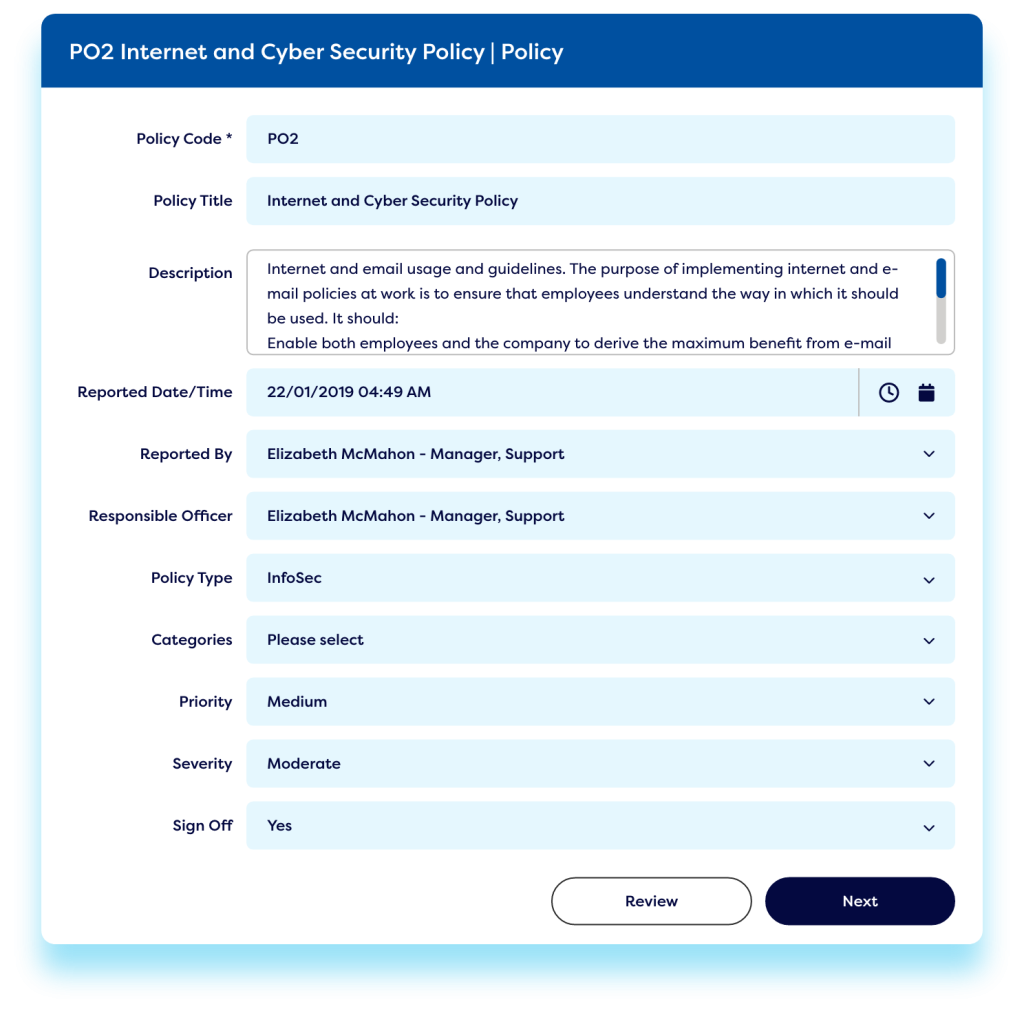
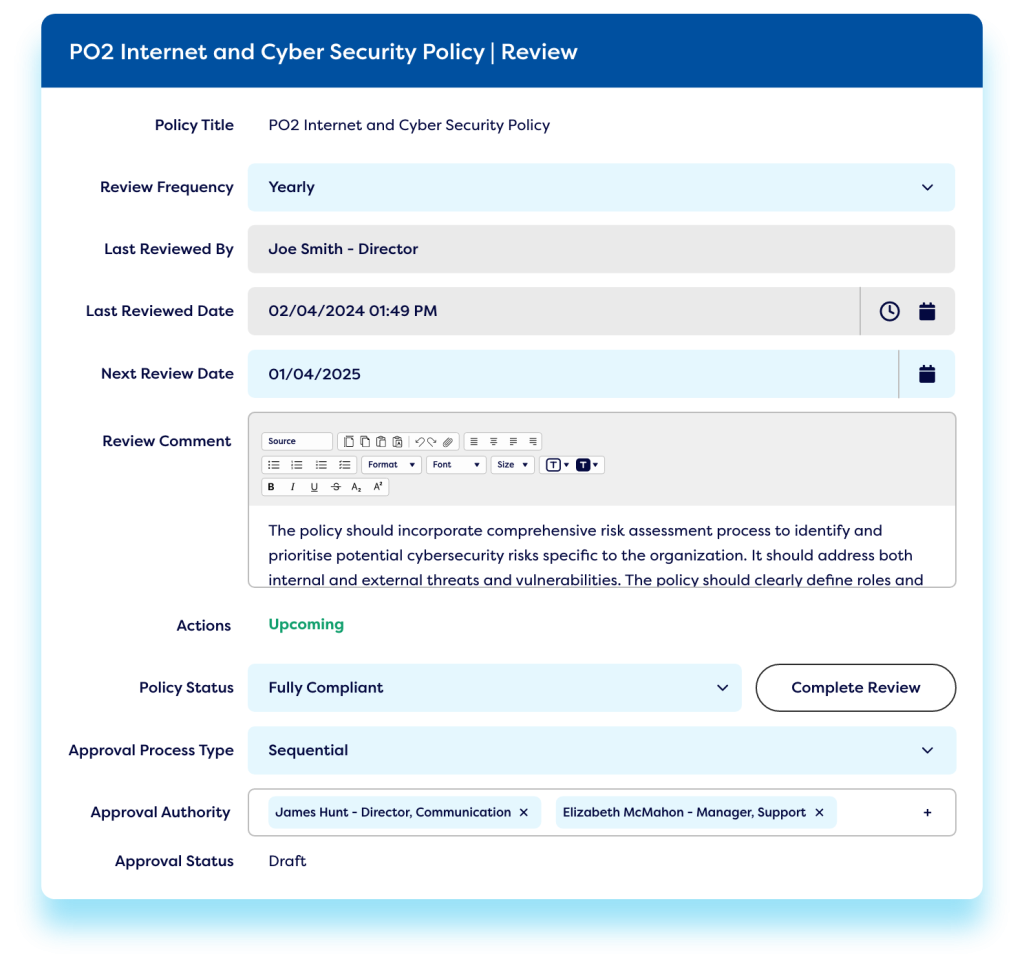
Automate Policy Revisions
Use automated workflows & notifications to send reminders when policies are due to expire, due for revision, or must be updated to align with new regulatory requirements. Workflows fully automate the entire revision process, fully documenting the source and date of the changes, version control history, and any signoffs and approvals.
Automate Policy Attestations
Staff can easily access the policy library in the corporate policy management software to view policies and attest to them online. Teams can also ask employees questions regarding extracts from the policy to ensure the policy has been read and understood and is being followed. This documented evidence can be used in employee tribunals where policies were not followed after the employee confirmed they would adhere.
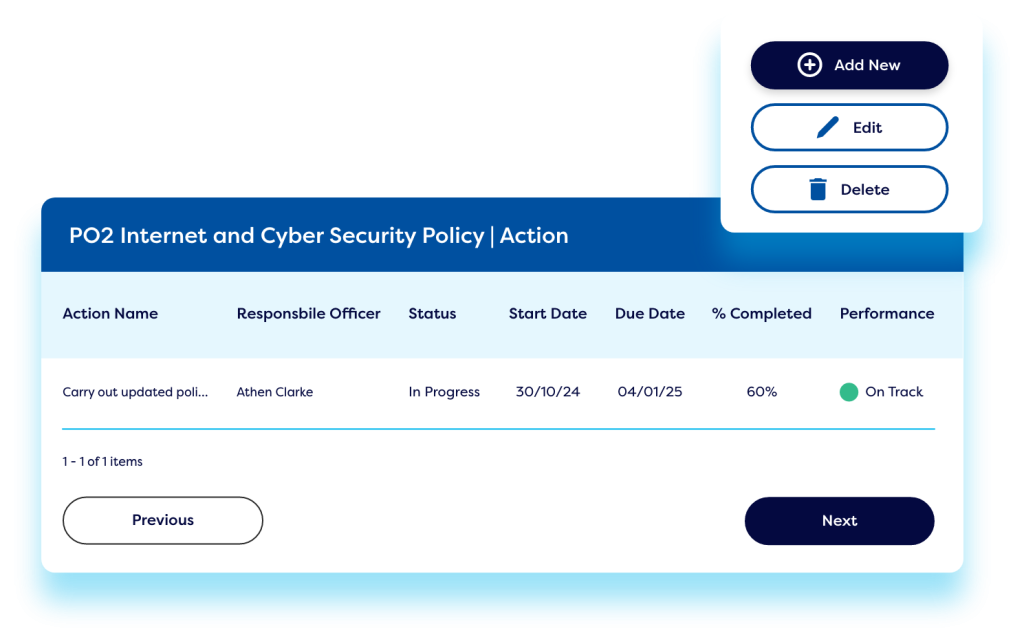
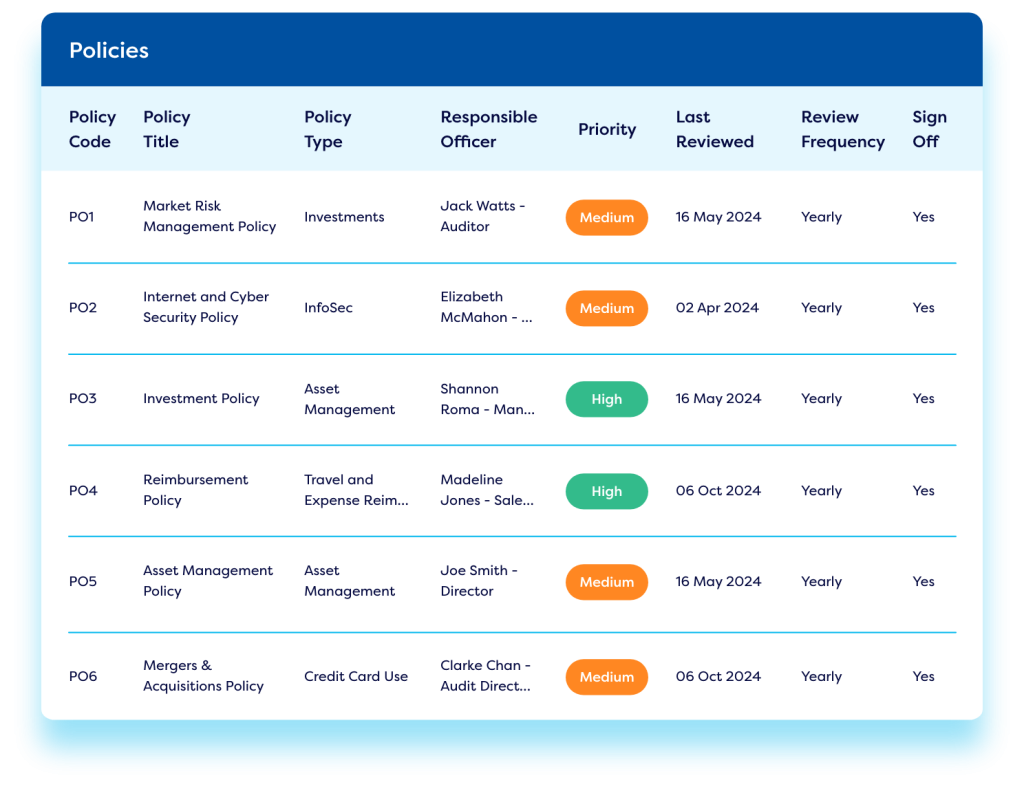
Report on Policy Status
Use our policy and document management software to easily run instant reports and view live dashboards to visualise policy status and understand compliance. Easily report on policies that are due for revision or due to expire to ensure policies are always current. Run management level reports on policy compliance to provide assurance.
Link Policies to Your Wider Business Operations
Easily map & link policies to integrate them into your wider GRC program – this integration can be used to trigger policy changes. For example, when risk levels get too high you may want to amend or add a new policy to control the risk. When a regulatory change occurs, you might need to update the corresponding company policy. It is vital to integrate policies and procedure documents into business operations to ensure they are relevant, up-to-date, and receive any necessary updates.

Your Policy Management Software Resources
The latest and hottest pieces of policy management software content to keep you in the loop.
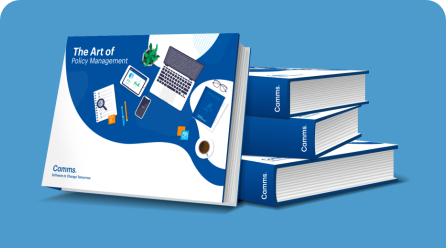
The Art of Policy Management
This eBook will offer a crash course into the art of policy management. It provides clarity on the value of policies, explores the challenges of manual policy management, and highlights the benefits of integrating policy management with wider GRC processes.

10 Signs that your Policy Management Process Needs an Upgrade
As a business grows, so too does its library of policies & procedures. Has your policy management team gotten noticeably busier? Perhaps policies are becoming

10 Clever Technology Capabilities For Compliance Officers
In this blog we take a tour through the latest technology capabilities available when you adopt a best-practice integrated GRC solution to manage compliance, find out which ones could benefit your organisation.
Why Choose Policy Management Software from Camms?
Data Security & Privacy
The Camms policy management tool is highly secure and certified to IT security standards like SOC Type 1&2, ISO 27001, and Cyber Essentials. It includes a detailed permissions hierarchy, encryption, and audit trails to safeguard data privacy and ensure compliance with security protocols.
Discover More About the Camms Policy Management Software
Frequently Asked Questions About
Policy Management Software
Policy management software solutions are typically cloud-based platforms that allow organisations to efficiently manage and streamline their policy lifecycle within a broader Governance, Risk, and Compliance (GRC) framework. These tools enable firms to create a centralised repository where all policies, procedures, and related documents are stored, ensuring easy access, version control, and proper tracking of policy updates. Organisations can oversee the entire policy management process, from drafting and approvals to distribution and review, using automated workflows and online forms.
These software tools centralise policy development, review, and distribution, automate approval processes, enhance collaboration, and provide reporting and tracking capabilities. By utilising effective policy management software, organisations can minimise risks, reduce administrative tasks, and demonstrate accountability through digital signatures and audit trails.
Leading policy management software often integrates with third-party regulatory content providers to keep firms informed of relevant regulatory changes that may require policy updates. This integration helps organisations quickly identify impacted policies, assign responsibilities, and implement necessary changes in a timely manner. Policy management platforms typically offer best practice templates and workflows to ensure that the creation and revision of policies align with industry standards and regulatory requirements ensuring firms have the right policies to govern their organisation effectively.
Most policy management software solutions provide customisable workflows to support the specific needs of different industries, such as healthcare, finance, or manufacturing. These workflows automate the approval, review, and distribution processes, ensuring that policies are consistently followed across the organisation. Additionally, these platforms often feature dashboards and reporting tools that give teams a comprehensive view of the status of their policies, helping to ensure compliance and mitigate risks associated with policy lapses or inconsistencies.
By integrating policy management with other GRC processes, these solutions offer a unified approach to managing organisational risk, compliance, and operational efficiency. This holistic view enables organisations to better understand how policies impact overall risk and compliance efforts, leading to more informed decision-making and a stronger governance structure.
Businesses need policy management software to streamline the creation, distribution, and management of policies, ensuring that all employees have access to the most up-to-date information and adhere to organisational standards. It helps businesses maintain compliance with regulations, mitigate risks, and avoid costly penalties and streamlines policy lifecycles.
Policy management software also automates policy lifecycle workflows, eliminating admin and speeding up policy approvals and amendments – ensuring staff always have access to the latest policy and supporting ongoing compliance. Policy management software also provides valuable insights through reporting and audit trails, enabling businesses to monitor compliance, address gaps, and make informed decisions. Many firms need policy management systems to ensure regulatory compliance and to improve operational efficiency and eliminate admin.
Policy management platforms typically include the following key features:
- Policy lifecycle management software usually offers an online searchable centralised policy library to store all policies, procedures, and related documents.
- Version control and document history to always know which version of the policy is current and easily look back on when policies were amended and what was changed.
- The best policy management software offers workflows to streamline and automate the policy lifecycle process for approvals, signoffs, review management, and policy amendments & updates to support policy development and review.
- Policy document management software usually offers search and filtering options to easily find specific policies and related documents and understand their status and expiry dates.
- Online attestations – enabling employees to read and agree to policies online and keep a record of who agreed to comply and when.
- Reporting and analytics to visualise key metrics regarding, compliance status, pending reviews, expiry dates, and employee engagement with policies.
- Access controls and permissions to make sure the correct staff members are involved in policy approvals and signoffs and ensure all relevant staff can access policies that are relevant to them.
- Most policy management tools offer mobile access allowing staff to carry out policy management related tasks and read and attest to policies on their phone.
- Some policy management platforms offer regulatory compliance capabilities allowing firms to receive regulatory updates and easily amend the policies & procedures impacted by the change.
- Most policy and document management platforms also offer other GRC capabilities in the same platform including; risk management, regulatory compliance, audit management, incident management, health & safety, ESG, and more.
Policy & procedure management software platforms are typically used on a company wide basis to standardise the way policies and procedure documents are managed and attested to. This usually includes HR policies around employee rights, maternity policy, holiday policy, and code of conduct. These tools are also used to store IT related policies regarding data privacy protocols and equipment usage. Health & safety policies are typically also managed in a policy management tool. Most departments are structured and governed using multiple policies and procedure documents – storing these centrally makes them easily accessible and ensures they are all managed in a consistent way.
Policy management software handles policy exceptions by providing a structured process for submitting, reviewing, and approving exception requests. When an exception is needed, users can submit a request through the software, detailing the reasons, associated risks, and the specific policy in question. The software then triggers an automated workflow, routing the request to the appropriate stakeholders for review and approval, ensuring that the request is handled efficiently and consistently.
Once the exception is approved, the software tracks and documents the exception, including any conditions or time limits. This ensures that all exceptions are recorded and monitored, allowing organisations to maintain transparency and compliance. The software also facilitates periodic reviews of approved exceptions to determine if they should be renewed, modified, or revoked, helping to ensure that policy exceptions are managed responsibly and in alignment with organisational goals.
When choosing policy management software, firms must consider:
- Is the policy management software highly configurable, allowing customisation of out-of-the-box processes to meet bespoke organisational needs?
- Do the security features of the policy management tool meet your IT team’s requirements, and is the platform certified to cybersecurity standards like ISO 27001, SOC Type 1 & 2, and Cyber Essentials?
- Does the policy management platform integrate with regulatory content providers to offer real-time notifications of regulatory changes to trigger policy amendments and updates?
- What reporting capabilities does the policy management platform offer, and do they align with your internal and regulatory reporting needs?
- Does the policy management software encompass broader GRC capabilities within the same platform, including risk management, cyber risk management, regulatory change management, compliance, third-party risk management, incident reporting, strategic planning, ESG, and project management? Availability of these functionalities support the future scalability and maturity of your program towards integrated GRC.
- Does the policy management solution automate reporting through intuitive dashboards & real-time reports – enabling teams to easily create a view of their upcoming policy related tasks and ensure timely completion.
- Does the policy management tool provide an audit trail of policy related activities and sufficient reporting outputs to satisfy both internal stakeholders and regulatory requirements?
- Consider the cost-effectiveness and pricing model of the policy management software, this is usually based on the number of capabilities required, the number of users, and any implementation and configuration costs.
- Will the policy management software vendor offer a free demo or a free trial?
- Firms should consider the ease of use and scalability of the platform to ensure is it widely used and adopted and that they can add more functionality as the firm grows and needs evolve.
- Managing policies manually often results in poor-quality policy status data, due to issues like poor data governance, data entry errors, copy-paste mistakes, overwritten information, and incomplete fields.
- Manual policy management causes compliance data to be scattered across various, non-integrated spreadsheets, leading to inaccurate reports that undermine the quality of decision-making and result in outdated policies.
- Relying on manual processes without automation slows the policy lifecycle, increasing the risk of outdated and inefficient policies.
- Unstructured manual policy management hinders organisations from effectively demonstrating compliance due to a lack of clear documentation.
- Fragmented processes and isolated data make it difficult to align compliance obligations with the corresponding policies.
- Inconsistent risk frameworks and siloed data prevent organisations from comparing policy data across different sites, complicating the demonstration of compliance across departments and locations.
- Policy management software enhances regulatory compliance by linking policies to the relevant regulatory change notifications.
- A policy management system generates automated policy reports and facilitates efficient record-keeping, offering robust evidence of compliance to auditors and regulators.
- Policy management software can enhance policy management by automating tasks such as policy monitoring, report generation, and policy audits, reducing the administrative burden on staff and minimising human error.
- Policy management software fosters a culture of compliance where staff clearly understand and adhere to policies and regulations, with features for online attestations.
- Policy management tools achieve cost savings by reducing the expenses associated with policy administration – minimising the risk of compliance violations, fines, and penalties.
- Policy management platforms enable organisations to generate predefined reports for various policies and their status & expiry date and their linkages to regulations – facilitating ongoing monitoring and preventing non-compliance.
- Policy management tools streamline workflows related to policy creation, review, and approval by aiding in data collection, analysis, validation, and report submission, automating the entire policy lifecycle.
- Policy management software supports organisations in managing and monitoring policy-related activities by streamlining processes, identifying knowledge gaps, managing tasks through workflows, and generating digital audit trails.
- A policy management system promotes cyber security awareness by actively promoting and sharing IT policies and encouraging adherence – when coupled with security awareness training this can build a resilient cybersecurity posture.
- When using policy management software firms experience improved compliance adherence and streamlines policy governance.
- A policy management system supports organisations with managing policies and procedures centrally – providing assurance that processes are being followed and the organisation is compliant.
Get started and request a demo
Fill out our simple form to see the Camms policy management software in action.
